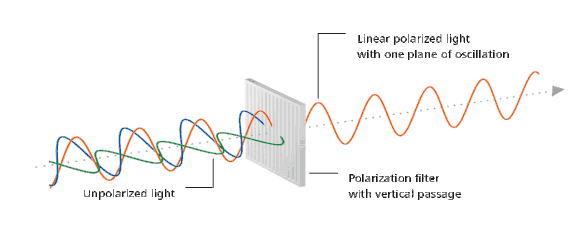|
Want a quick review? Then this video has you covered. More more detailed explanation, read on |
|
Light is form of electromagnetic radiation, which is a transverse wave. However, the plane at which we receive those transverse waves is not all the same. We receive many planes of electromagnetic radiation. This is referred to as unpolarised light.
Polarisation is the process by where only one plane of electromagnetic radiation is allowed to pass.
|
The property of polarisation is evidence of a wave nature of light.
The filter (as seen at right) allows only the planes that are parallel to the polarisation axis to pass through. The image is deceiving though - not only does it allow vertical planes to pass through, but ALL components of the other planes that are vertical to pass through as well. |
|
|
As a result there is a change in intensity between what enters and what leaves the polariser.
How does this occur, and what is the mathematical model that explasin this chnage in intensity. Watch the video for a fuller explanation |
Sample Problem
We are now ready to try a sample problem
Below is a sample problem with a video that explain how to solve it. It is suggested you try the problem beforehand, as this actually aids understanding, even if you are unsure if you are correct.
We are now ready to try a sample problem
Below is a sample problem with a video that explain how to solve it. It is suggested you try the problem beforehand, as this actually aids understanding, even if you are unsure if you are correct.
|
polarisation worksheet for you to try
|
|
Interactive
This interactive looks at how polarisation works. By Tom Walsh
(Please not that this is a simplified model.
The filters are actually made up of long molecular chains which absorb EMR that run in the same direction of the chains.
Therefore it is better to refer to the polarisation axis (which is what these red boxes represent) which are actually perpendicular to these molecular chains.
This interactive looks at how polarisation works. By Tom Walsh
(Please not that this is a simplified model.
The filters are actually made up of long molecular chains which absorb EMR that run in the same direction of the chains.
Therefore it is better to refer to the polarisation axis (which is what these red boxes represent) which are actually perpendicular to these molecular chains.


